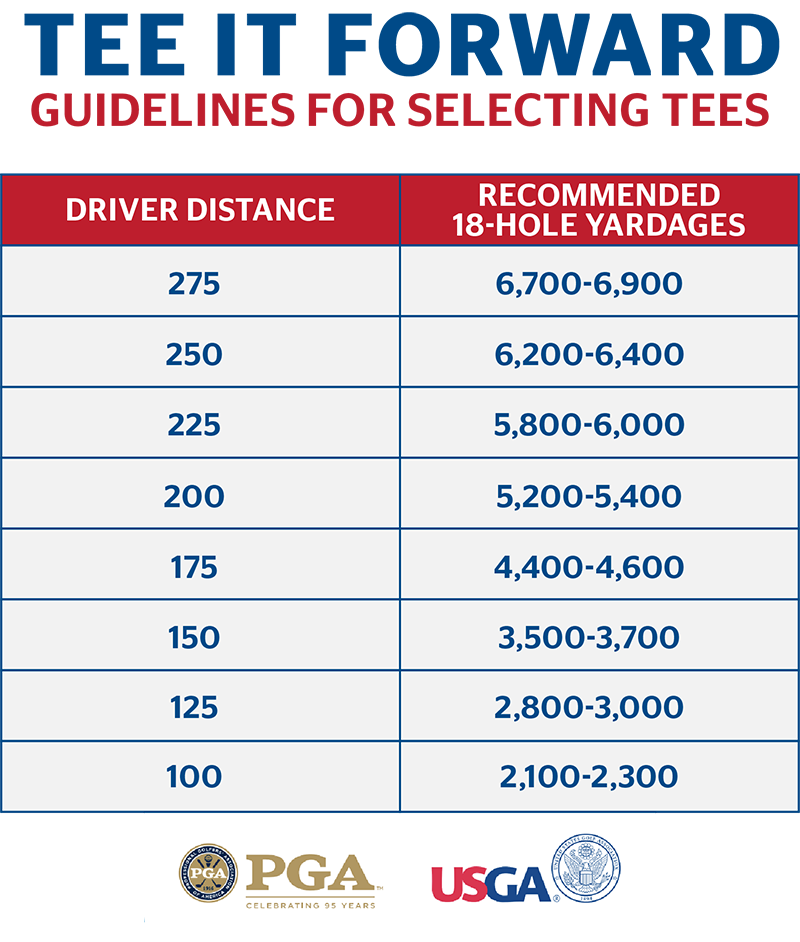Life at 6,000 Yards – Why tees (should) make all the difference
by Crai S. Bower
 I’ve never been a fan of beige, tan, khaki and other bland hues.
I’ve never been a fan of beige, tan, khaki and other bland hues.
But color wheel mandates aside, when golfing at Mauiʻs Kāʻanapali golf courses last fall, I found myself seeking out a beige shade, specifically the sand tees. Theyʻre not hard to find, you just have to cruise past the blacks, blues and, yes, the whites to settle in right behind the forward reds. My choice is more about distance than palate – 6,000 yards to be exact.
The sand tees can mean different yardages on different courses. I should have insisted I play the green tees when a couple of friends joined me at Chambers Bay late in the summer. My playing partners, fellow hockey players who are 15 years younger and, because they still skate several times a week, in much better condition, would never deign to play from 6,000. The 6,020-yard green tees would have been perfect for me on this beastly layout, but I deferred and spent the entire round never getting a grip on 6,586 yards.
I’m not going to dwell on Course ratings, but the 70.2 green tees made much more sense for all of us than the 72.4 from the sand tees.
This is especially true for one friend of mine, who stripes his drives about 290, though what direction these screamers take is as consistent as the wind in February. His drives are so erratic that I usually win our Nassau bets.
I’ve played with plenty of other foul ball bombers, twice in the last seven days in fact. One drove a 310-yard green but shot 111 on Willows Run’s shorter Coyote Creek course. The other hit so many extra drives from the blues at Jefferson Park before nailing one that my playing partner and I set up an over/under bet on the number of balls used per hole.
Which begs an interesting question: Which should determine your set of tees, how far you hit the ball, or your Handicap Index? Not surprisingly, this being golf, opinions spray in every direction. Athletic Motion Golf, a social media account, suggests multiplying how far you hit your 5-iron by 36. Because I hit my 5-iron about 180 yards, I should play from 6,480, but that doesn’t sound (or feel) right.
The PGA of America suggests most amateurs “Tee it Forward,” noting a 6,700-yard distance for us is equivalent to a tour pro playing from 8,100 yards. Citing this information, my GPS app of choice, 18 Birdies, features a Driving Distance chart. If you launch the ball 250 yards consistently, play from 6,200-6,400 yards; knock it in the 225 range, consider 5,800-6,000.
 The USGA notes 99 percent of professional golfers think amateurs will have more fun if they play from the appropriate tees, yet 93 percent of these pros (men and women) said it is common for amateurs to choose tees that are too long for their ability.
The USGA notes 99 percent of professional golfers think amateurs will have more fun if they play from the appropriate tees, yet 93 percent of these pros (men and women) said it is common for amateurs to choose tees that are too long for their ability.
If any data confirmed that golf is indeed a game where we hurt ourselves before ever hitting a single shot, only 53 percent of 20,000 of amateurs felt that golfers hit from the proper tees and 57 percent said the tees they regularly choose were too long for their own games.
How absurd is that? Can you imagine playing pick-up basketball and asking to have the rim raised three feet, or reducing the size of a four-by-six hockey goal, or extending first down yardage to 15 yards?
Of course, golf being golf adds another wrinkle to course length: the too-short course.
As frustrating as it is to hit driver, 3-wood, long-iron on a par-5, as I learned playing TPC Scottsdale from the tips a couple of years ago, I’m equally perturbed playing driver-wedge on the majority of par 4s somewhere.
Ditto for par 3s that average less than 140 yards. I may not want to hit 5-wood on a 200-yard par 3 too often, but I like the challenge of going mid- or long-iron more than feeling a well-smacked putter might do the job.
The USGA uses what I call the “6-Iron Rule” to keep us Goldilocks golfers in check.
To paraphrase:
“Par 3s feel too short with a gap wedge, too long with a fairway wood but just right with a 6-iron. Par 4s feel too short with driver-wedge, too long with driver-fairway wood and just right with driver 6-iron.”
Par 5s are a little different. They “feel too short with driver-fairway wood-pitching wedge, too long with driver-fairway wood 6-iron, and just right with driver-fairway wood 9-iron.”
And, since we can’t reference Goldilocks without a bear, the Golden Bear (Jack Nicklaus) says, “All of us deeply committed to the game constantly encourage golfers of all skill levels to play the proper tees, but too often golfers want to bite off as much of the golf course as they can. What ends up suffering is their scorecard and their overall enjoyment.”
Nick Faldo, never one to mince words, says golfers should start at the red tees and then move steadily back once they’ve proven they can shoot low scores from each distance.
But c’mon, who is going to do that? Probably the same people who spend 80 percent of their practice time working on their short game and only 20 percent at the range. You know, those people like my former father-in-law who I outdrove by at least 50 yards only to have him beat me with his impeccable short game. I never did beat him.
 As a former hockey teammate and scratch golfer Patrick Kearney said when he used only a putter and one other club to beat seven of us at Surrey, B.C.’s Northview Golf and Country Club, “A 510-yard par 5 is just three 7-irons in a row.”
As a former hockey teammate and scratch golfer Patrick Kearney said when he used only a putter and one other club to beat seven of us at Surrey, B.C.’s Northview Golf and Country Club, “A 510-yard par 5 is just three 7-irons in a row.”
As I know but rarely consider, scoring well as an amateur is about recovery shots and finding the right number for full swings. As a mid-handicapper I can spin the ball just as well as I can “saw off a 5-iron.” As in, I can’t. I do have decent touch around the greens, that is until I start thinking I have decent touch around the greens. In other words, I’m a mid-handicapper.
Given my innate talent at finding a way to bogey most of the holes I play regardless of exact length, I can see why using one’s handicap to pick the tees makes sense. There’s no need to fool yourself into thinking you hit your 5-iron 200 yards because of that one pure stroke last spring either.
The Handicap Rule is surprisingly straightforward: 5 or better play from the tips, 5-12 pick blues, 12-20 play whites. Yellows are for low handicap women and short-hitting seniors. Reds are for high-handicappers and average women.
Once we toss our egos into the rough we would think it would be easy to pick which tee to play, were it not for the “middle school” dilemmas: peer pressure, wanting to appear strong and thinking we’re better than we are. (My favorite example of the latter is how often I declare “finally” when I sink a birdie putt, as if I average more than one birdie a round.)
There may be as many formulas as swing thoughts about this, but here’s what I consider the right approach when selecting your distance. Choose the tee whose yardage is within the average range of your ability to keep pace of play, and your pleasure, moving right along.
Crai S. Bower writes scores of adventure travel articles a year for over 25 publications, including golf stories for American Way, Hearst Media and Journey magazine, among others. He appears regularly on the American Forces Network as a travel commentator. Visit his site at flowingstreammedia.net.





